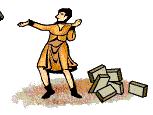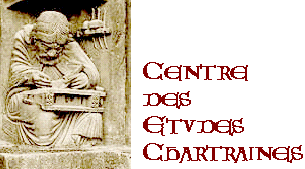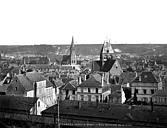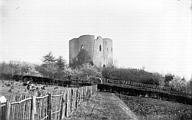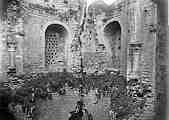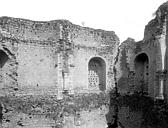This
Site is Sponsored By : Christopher's
Book Room
(specializing in Books on the Middle Ages)
And is Hosted by the remarkable Ariadne's Thread.
Nota Bene: The new material herein is
under Copyright.]
The "Tour Guinette"
at Étampes
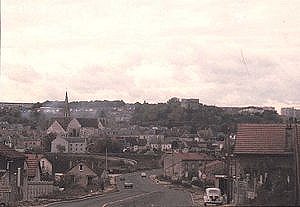
[Photo: CC©]
The twelfth century topography of the important royal town of Étampes was dominated by the tower of the King (Louis VI/VII), which is visible here on its hill at the center of this view. The large church with tower on the lower left is the royal collegial of St. Mary (eleventh-thirteenth centuries); the smaller tower to the right of it is the parish church of St. Basil. The sprawing rest of the town, the fauvbourg of St. Martin is off the frame, to the left.
Founded (perhaps) in the Merovingian
period, and greatly expanded during the
reign of Robert the Pious (early 11th century), by the twelfth century Étampes
was
an important and statigically situated Royal Town (as can be seen by Abbot
Suger's
narrative), astride the old Roman road, roughly midway between Paris and Orleans,
in the very heart of the "Royal Domain, "the elongated geographic
region of North
Central France more or less under the King's direct control, stretching from
Laon
to Bourges.
On its hill West of the town, the ruins of the quadrilobed
keep of the
castrum built, probably, by Louis VI (+ 1138) to secure his important
property still dominates the skyline:
(click on a thumbnail image to view a larger
one)
On closer examination the true size and scale of the massive structure becomes apparent:
And the remains of the interior demonstrate that a considerable
amount of decorative
finish work was expended on the construction of this castle where the peripatetic
King
is known to have spent considerable time during the reigns of Louis VI and
VII:
Eugene Lefevre-Pontalis, a distinguished
French architectural historian of the late
19th/early 20th century (who was one of the first trained scholars to seriously
look at
this monument and who took some of these photographs), was of the opinion
that the
architectural details of the interior of the tower suggest connections with
the early
12th century campaigns of the construction of the major church of the lower
town,
the Royal Collegiate Abbey of St. Mary.
Vintage photographs courtesy of the "Base de Données Mémoire, ministère de la Culture et de la Communication - direction de l'Architecture et du Patrimoine" : http://www.culture.fr/documentation/memoire/pres.htm
![]()
And
is maintained by
Christopher Crockett
(who absolutely cannot be held
responsible if the above condition is not
rigorously adhered to).
Your input, comments and even (mild, gentle)
criticisms
are welcome and solicited.
Write me at:
bccrockett@usa.net
And
with special thanks to Susan R. Dixon,
Creatrice of
![]()
Specializing in :
Web Designing
with the goal of enabling organizations
to transform the way they create and interact with the world.
And sponsor of Medieval
WebArtists, a cooperative project
providing server space for those working with any body of
scholarship about medieval art, history, literature, or life
that they wish to put on the web, an Ideal Home for Scholars
who have no academic affiliation and therefore little access
to stable accomodations for their work.
Meanwhile, this Site is Definitely
